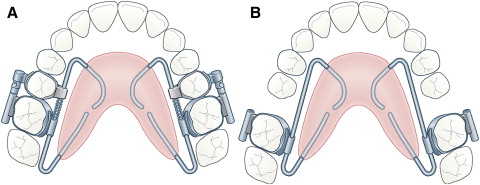Introduction
The aim of this study was to evaluate the treatment effects of the First Class Appliance (FCA) (Leone, Firenze, Italy) used for the distalization of maxillary first molars in patients with Class II malocclusion and mixed dentition.
Methods
According to the results of the power analysis for sample size calculation, 32 consecutive patients with bilateral Class II molar relationships were initially included in the study. After application of the inclusion and exclusion criteria 26 patients remained for the final evaluation. They were randomized into 2 groups: treatment group (n = 15) and untreated control group (n = 11). Lateral cephalograms and dental casts were obtained before and immediately after distalization for the treatment group, and initially and approximately 22 weeks later for the control group. Statistical evaluation of the variables included the mixed 2-way analysis of variance at P <0.05. The method error was also estimated.
Results
The mean treatment period to achieve a full Class I molar relationship was 17.2 weeks. Analysis of the data showed significant distalization of the maxillary first molars produced by the FCA (mean: 4.00 mm) when compared with the untreated group (mean: 0.95 mm). The rate of molar movement was 1.00 mm per month, which, however, was associated with distal tipping of the first molars (8.56°) and anchorage loss of the anterior dental unit in terms of overjet increase (0.68 mm), and mesial movement (1.86 mm) and inclination (1.85°) of the first premolars or first deciduous molars. The maxillary first molars also moved buccally (1.37 mm), but no significant distal rotation occurred.
Conclusions
The FCA is an efficient noncompliance appliance to distalize molars in the mixed dentition without distal rotations. However, these movements are associated with distal molar tipping and anchorage loss of the anterior teeth.
Editor’s comment
In recent years, there has been much talk about noncompliance mechanics. The plethora of appliances now available includes the Jones jig, distal jet, pendulum, Keles slider, repelling magnets, compressed coil springs, and molar distalizing bows, not to mention orthodontic implants and miniscrews. Each has unique applications and advantages, along with some problems, such as anchorage loss, distal molar crown tipping, molar rotation, and proclination of maxillary anterior teeth. The aim of this randomized controlled clinical trial was to evaluate the dentoalveolar and skeletal treatment effects of the FCA when used for distalization of the maxillary first molars in patients with Class II malocclusion in the mixed dentition.
Thirty-two consecutive patients with Class II malocclusion were originally included in the study, and 26 remained for the final evaluation. They were randomized into 2 groups: the treatment group (n=15), which received the FCA for the first phase of the overall treatment, and the untreated control group (n=11), with no orthodontic treatment during the examination period. Maxillary first molars were distalized into a Class I relationship in a mean treatment time of 17.2 weeks. This distalization did not take place bodily, however; significant distal crown tipping (8.56°) in relation to the SN line occurred. In contrast, the maxillary molars in the untreated group showed mesial tipping of the crowns (–1.45°).
An issue that should be considered with both conventional and noncompliance distalization appliances is that the molars must be retained in position after distalization until the second phase of treatment with fixed appliances is completed. To prevent or at least minimize relapse, a Nance button must be used as a retention device.
The strength of this study would have been greater if the final records had been available for evaluation after all orthodontic treatment. According to the authors, “the FCA is an efficient appliance to distalize the maxillary first molars in patients with Class II malocclusion in the mixed dentition without patient compliance.”





